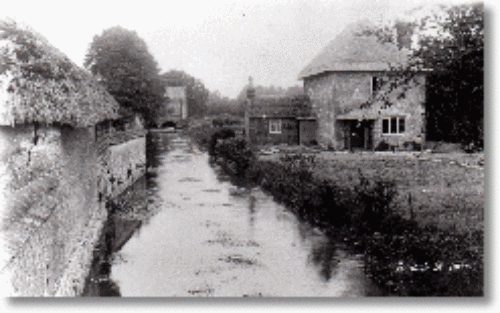The Mill & Mill House

The earliest record of a mill in Berwick was in 1257, when Laurence Miller had the lease of a mill for his life time for 22 shillings each year. Asserton had a mill of its own in 1309, and in Berwick St James John atte Mille paid 5s tax in 1332.
On Wednesday 20th May 1478 William Birde delivered a new millstone for the Queens Mill, at Berwick. At that time Berwick belonged to the Crown (Duchy of Lancaster).
John and Charles Sandell were the millers in 1578 when Wiltshire Quarter Sessions ordered that both Charles Sandell and Joane Long “whome he begat with childe shalbe whipped …”
In the 1500’s Anthony Fenton was the miller when there was a long argument between the representatives of the Queens Mill in Berwick and Sir Walter Hungerford’s new mill in Winterbourne Stoke because that mill was taking the water from Berwick’s mill.
The corn grinding mill straddled the river by Mill House at the south end of the village, approximately at the site of the present footbridge.
The mill was owned by the landowner of the village and leased on long leases to another who then ran it himself, or employed a miller.
The Gilbert als Netton family had the lease of the Mill in the 1600’s and the first half of the 1700’s. They were a well to do family who lived at the north end of the village who leased several properties and land.
In 1776 Thomas Miles was granted the lease at a rent of £1 5s 6d. He continued to hold it until his death in August 1812. He also had leases for several other houses and land. 1796 - “House, Grist Mill and
Garden of 1r 37p with the Mill Bank in Church Marsh 1r 13p being of annual value £21.0.0 with various closes of land making a total of 6a 20p for a rent of £1 5s 6d. When Thomas Miles died in 1812 the tenancy went to Thomas Godwin. (The owner being Lord Malmesbury.) The House, Mill, Garden and Church Marsh and Bank 3r 37p in 1843 was lived in by one of the employees of Mr E C Pinckney (the tenant of the village) who lived in Berwick House.
Shortly thereafter a new Mill was built in the Farm Yard slightly upstream. It is still there.
Mill House itself was built in 1785 as a two story cottage with 2 rooms downstairs by Thomas Miles, for the miller. He put a stone over the door carved “T M 1785”. In 1898 it was a Stone and Thatch cottage with 3 rooms, and in 1921 a small stone, flint and thatch cottage with 4 rooms.
The miller in 1891 was Jacob Rolfe aged 29. He was living with his parents in what is now The Old Post Office. In 1901 he was a widower with two young children, living with his now widowed father in the same cottage - but he is no longer recorded as the miller.
In 1910 William Humphries and his family lived in Mill Cottage, and from 1921 Shepherd Lawes and his family.
Mill Cottage was converted into a 3 bedroomed house by Mrs K F Collins, for herself, around 1960. At the same time the yard on the west of the river was converted into garages, gardens and the entrance to Mill House, with the footbridge as access.
The original access was from the road to the south, over the small stream by a little footbridge which went only a few years ago, the gate is still in the hedge.
The house was first extended in 1969, and Mertens End added in the 1988.